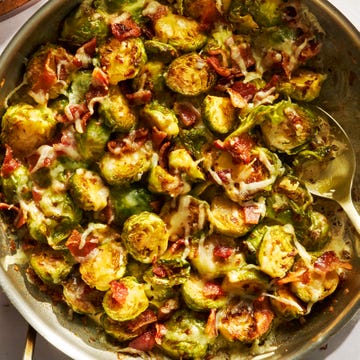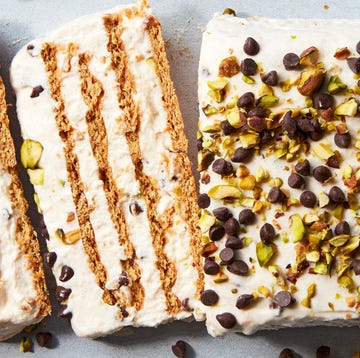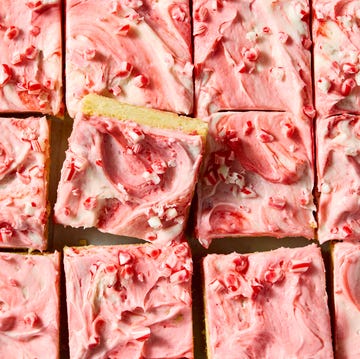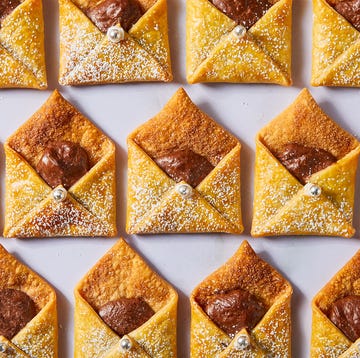If you've ever felt like building a gingerbread house is some cosmic lesson in humility—or futility—you're not alone. We've seen and had our share of holiday baking fails, and in an effort to have our expectations come at least somewhat close to reality this year, we turned to the pros to uncover the biggest gingerbread house-making mistakes—and how to fix them.
Start with a Great Base
Choosing the right gingerbread recipe is critical, and it goes against what you'd typically look for in a cookie. You want a sturdy dough with a good amount of flour, says recipe developer Jason Schreiber, who honed his baking skills working under Sweet Genius's Ron-Ben Israel for five years. Try this recipe, which uses a whopping 9 1/2 cups, giving you plenty of dough to make extra walls and spare parts. (Another crucial tip, since Murphy's Law is always in full effect when baking—no matter how careful you are.)
Because the house needs to be sturdy, the cookies won't be the tastiest—and, since they'll be sitting out for at least a few days, they'll get stale anyway. If you want some treats people will devour, try serving one of these gingerbread desserts alongside the house.
Sketch It Out
Unless you're using a box kit, you'll need to create a template to make sure every piece of the house is cut to the right size. Draw out each part of the house—to scale—on sheets of paper, then cut them all out and try assembling the house using tape. "If it doesn't work with paper, it's not going to work with cookies," Schreiber says.
Place the paper pieces on top of rolled-out dough to cut out each shape you need. The dough will spread a little while baking, but following a basic template will ensure they're as close to fitting as possible.
Go Easy on Yourself
If you don't bake and your childhood school projects often turned disastrous, cut yourself some slack and try a foolproof gingerbread house shape. An A-frame house, like the one below, only requires two key pieces—no balancing a roof on walls—making for a simpler, sturdier cookie abode. Australian baker Katherine Sabbath used this design to teach 70 people how to make gingerbread houses, and not a single one fell apart.
If you're a pretty seasoned baker and you feel like a challenge, you could always try recreating one of these masterpieces.
Give Your Cookies the 'Press Test'
While you'd normally pull cookies from the oven when they're just golden on the edges, the walls and roof of your gingerbread house need to be cooked all the way through. The entire cookie should be lightly browned, and if you press your finger on the cookie, it shouldn't have much give. "You want the cookies to feel pretty firm," Schreiber says.
Cool Down and Don't Move
Whatever you do, don't try to move the cookies to a cooling rack right away. "They'll break if they're still warm, especially since you're working with such large pieces," Schreiber says.
Leave the cookies right on the sheet pan to cool completely, which could take an hour or so. If you need to use the cookie sheet right away, Schreiber recommends letting the cookies cool on the sheet for 10 to 15 minutes, then carefully lifting the parchment paper underneath the cookie and moving it onto a rack to cool the rest of the way.
Bust Out the Saw (Sort of)
Since the cookies will spread a little while baking, you may notice that the edges are a little uneven or don't exactly fit together the way you wanted them to. If that's the case, use a serrated knife or microplane to gently trim or grate the edges until they're even, Schreiber says.
Think 'Toothpaste,' Not 'Paint'
Royal icing is the absolute best frosting to use to hold a gingerbread house together, but the trick is getting the consistency just right. Even if you're using the icing that comes with a box kit, it's worth keeping a little powdered sugar and water on hand. When you're building the house, you want the icing to be as thick as toothpaste—adding powdered sugar will help it get to that consistency, if it's runny, and water will help loosen it, if it's too dense—and it should still be tacky enough to make the walls stick together.
"Too much powdered sugar can make it hard to squeeze out of a piping bag, and it will lose some of its stickiness," Schreiber says.
When you're ready to decorate, you want to add enough water to the royal icing to give it a lotion-like consistency.
Corner Yourself
The sturdiest way to build a gingerbread house is to start with one corner. Grab two walls and adhere them using royal icing to create a right angle, Schreiber says. It's even easier if you work with a friend, who can hold the walls steady so you don't accidentally stick them askew.
Think Minty or Sour Over Sweet
Hard, dry candies—like sour balls and peppermints—will last longer than chocolates and jellies before sliding off the house, Lauren Chattman and Susan Matheson, coauthors of The Gingerbread Architect, told Redbook.
Plan a Cover-Up
Even the pros deal with decorations that don't turn out the way they'd hoped. If the bottom half of your house looks a little messy—or you just want a more polished, finished look—try using yogurt-covered pretzels to make a fence, or covering marshmallows in green icing for a "boxwood hedge," suggests Chattman and Matheson.
And, if the worst happens and your house does collapse, you can always try one of the funniest "fixes" we've seen: Pop a dinosaur in the mix and make it look like he's terrorizing the countryside. There. The fail was totally deliberate, and your centerpiece is now all the more memorable.
Follow Delish on Instagram.














